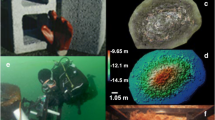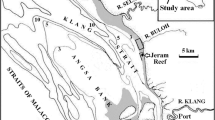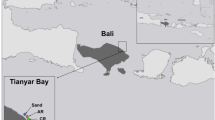Abstract
Artificial reefs have been constructed throughout the world, but their effects on adjacent soft-bottom communities are largely unknown. In December 1986, we investigated the influence of Pendleton Artificial Reef (PAR) in Southern California on the abundance of infauna in the surrounding sand bottom. PAR was constructed in 1980 of quarry rock placed in eight piles, or modules. The artificial reef altered the grain-size distribution of sediments around the reef; sediments close to the modules were coarser than those 10 or 20 m away from the modules. Densities of one of the two most common species, the polychaetePrionospio pygmaeus, were lower near the reef, perhaps due to foraging by reef-associated predators or because the habitat near the reef was less suitable. We found no evidence that foraging by reef-associated fishes caused a widespread reduction in infaunal densities near the reef, and in fact the other most common taxon,Spiophanes spp., had higher densities near the reef. The most conspicuous effect of the artificial reef concerned the tube-dwelling wormDiopatra ornata, which only occurred in close association with the modules. In addition, total infaunal density and the densities of decapods, echinoderms and sipunculids were higher withinD. ornata beds than outside the beds. These results indicate that the densities of some species were enhanced, and others depressed, around the reef, but that the overall effect of the artificial reef on the surrounding infauna was limited to a small area near the modules.
Similar content being viewed by others
Literature cited
Ambrose, R. F., Swarbrick, S. L. (1989). Comparison of fish assemblages on artificial and natural reefs off the coast of Southern California. Bull. mar. Sci. 44: 718–733
Anderson, T. W., DeMartini, E. E., Roberts, D. A. (1989). The relationship between habitat structure, body size and distribution of fishes at a temperate artificial reef. Bull. mar. Sci. 44: 681–697
Ban, S. M., Nelson, W. G. (1987). Role ofDiopatra cuprea Bosc (Polychaeta: Onuphidae) tubes in structuring a subtropical infaunal community. Bull. mar. Sci. 40: 11–21
Barnett, A. M., Gleye, L. G., Green, K. D., Johnson, T. D., Watson, W., Watts, S. D. (1987). San Onofre Nuclear Generating Station: monitoring studies on mysids and soft bottom benthos. Marine Ecological Consultants Biological Project. Final report to the Marine Review Committee of the California Marine Review Committee Inc., University of California, Santa Barbara
Bohnsack, J. A., Sutherland, D. L. (1985). Artificial reef research: a review with recommendations for future priorities. Bull. mar. Sci. 37: 11–39
Brenchley, G. A. (1982). Mechanisms of spatial competition in marine soft-bottom communities. J. exp. mar. Biol. Ecol. 60: 17–33
Carter, J. W., Carpenter, A. L., Foster, M. S., Jessee, W. N. (1985a). Benthic succession on an artificial reef designed to support a kelp-reef community. Bull. mar. Sci. 37: 86–113
Carter, J. W., Jessee, W. N., Foster, M. S., Carpenter, A. L. (1985b). Management of artificial reefs designed to support natural communities. Bull. mar. Sci. 37: 114–128
Davis, N., VanBlaricom, G. R., Dayton, P. K. (1982). Man-made structures on marine sediments: effects on adjacent benthic communities. Mar. Biol. 70: 295–303
DeMartini, E. E., Roberts, D. A., Anderson, T. W. (1989). Contrasting patterns of fish density and abundance at an artificial rock reef and a cobble-bottom kelp forest. Bull. mar. Sci. 44: 881–892
Elwany, M. H. S., Reitzel, J., Erdman, R. (1988). Modification of coastal currents by powerplant intake and thermal discharge systems. Report to the Marine Review Committee of the California Coastal Commission. Marine Review Committee, Inc., University of California, Santa Barbara
Emerson, R. R. (1975). The biology of a population ofDiopatra ornata at Santa Catalina Island, California. Ph.D. dissertation. University of Southern California, Los Angeles
Fager, E. W. (1964). Marine sediments: effects of a tube-building polychaete. Science, N.Y. 143: 356–359
Fauchald, K., Jumars, P. (1979). The diet of worms: a study of polychaete feeding guilds. Oceanogr. mar. Biol. A. Rev. 17: 193–284
Grant, J. J., Wilson, K. C., Grover, A., Togstad, H. A. (1982). Early development of Pendleton Artificial Reef. Mar. Fish. Rev. 44: 53–60
Gray, J. S. (1974). Animal-sediment relationships. Oceanogr. mar. Biol. A. Rev. 12: 223–261
Grove, R. S. (1982). Artificial reefs as a resource management option for siting coastal power stations in Southern California. Mar. Fish. Rev. 44: 24–27
Jessee, W. N., Carpenter, A. L., Carter, J. W. (1985). Distribution patterns and density estimates of fishes on a southern California artificial reef with comparisons to natural kelp-reef habitats. Bull. mar. Sci. 37: 214–226
Leeder, M. R. (1982). Sedimentology: process and product. George Allen & Unwin, London
Luckenbach, M. W. (1986). Sediment stability around animal tubes: the roles of biotic and hydrodynamic processes. Limnol. Oceanogr. 31: 779–787
Meyers, M. B., Fossing, H., Powell, E. N. (1987). Microdistribution of interstitial meiofauna, oxygen and sulfide gradients, and the tubes of macro-fauna. Mar. Ecol. Prog. Ser. 35: 223–241
Mosteller, F., Tukey, J. W. (1977). Data analysis and regression. Addison-Wesley, Reading, Mass., USA
Randall, J. E. (1963). An analysis of the fish populations of artificial and natural reefs in the Virgin Islands. Caribb. J. sci. 3: 31–47
Seaman, W., Jr., Buckley, R. M., Polovina, J. J. (1989). Advances in knowledge and priorities for research, technology and management related to artificial aquatic habitats. Bull. mar. Sci. 44: 527–532
Smith, R. I., Carlton, J. T. (eds.) (1975). Light's manual: intertidal invertebrates of the Central California Coast. University of California Press, Berkeley
Turner, C. H., Ebert, E. E., Givens, R. R. (1969). Man-made reef ecology. Calif. Dep. Fish Game Fish Bull. 146: 1–221
Wilson, K. C., Grant, J. J., Togstad, H. A. (1981). Pendleton Artificial Reef Annual Progress Report. Report to Southern California Edison Co., Rosemead, California. California Department of Fish and Game, Long Beach
Wilson, K. C., Togstad, H. A., Aseltine, D. A. (1984). Pendleton Artificial Reef Annual Progress Report. Report to Southern California Edison Co., Rosemead, California. California Department of Fish and Game, Long Beach
Wilson, W. H., Jr. (1979). Community structure and species diversity of the sedimentary reefs constructed byPetaloproctus socialis (Polychaeta: Maldanidae). J. mar. Res. 37: 623–641
Woodin, S. A. (1978). Refuges, disturbance, and community structure: a marine soft-sediment example. Ecology 59: 274–284
Woodin, S. A. (1981). Disturbance and community structure in a shallow-water sand flat. Ecology 62: 1052–1066
Young, D. K., Rhoads, D. C. (1971). Animal-sediment relations in Cape Cod Bay, Massachusetts. I. A transect study. Mar. Biol. 11: 242–254
Author information
Authors and Affiliations
Additional information
Communicated by M. G. Hadfield, Honolulu
Rights and permissions
About this article
Cite this article
Ambrose, R.F., Anderson, T.W. Influence of an artificial reef on the surrounding infaunal community. Mar. Biol. 107, 41–52 (1990). https://doi.org/10.1007/BF01313240
Accepted:
Issue Date:
DOI: https://doi.org/10.1007/BF01313240




